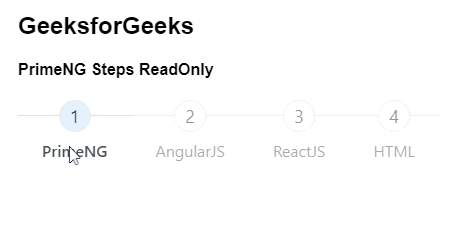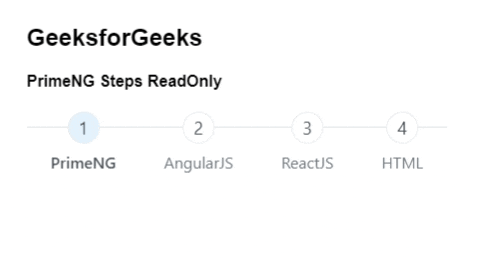Angular PrimeNG的steps属性
Angular PrimeNG是一个开源框架,拥有丰富的原生Angular UI组件,可用于出色的造型,这个框架可用于制作响应式网站,非常容易。在这篇文章中,我们将学习如何在Angular PrimeNG中使用steps属性。我们还将了解这些属性,以及它们在代码中的语法。
步骤组件用于指示或跟踪一系列过程的完成情况。
Angular PrimeNG steps属性:
- model。它是一个菜单项的数组。它是一个数组类型的数据,默认值为空。
- activeIndex。它是活动项目的索引。它接受数字作为输入数据类型,默认值为0。
- readonly: 它指定了项目是否可以被点击。它是布尔数据类型,默认值为真。
- style。它设置组件的内联风格。它的数据类型为字符串,默认值为空。
- styleClass。它是组件的风格类。它的数据类型为字符串,默认值为空。
创建Angular应用程序和模块安装。
第1步:使用以下命令创建一个Angular应用程序。
ng new appname
第2步:创建你的项目文件夹即appname后,使用以下命令移动到它。
cd appname
第3步在你给定的目录中安装PrimeNG。
npm install primeng --save
npm install primeicons --save
项目结构:它将看起来像如下。
运行应用程序的步骤:运行以下命令以查看输出。
ng serve --open
例子1:下面是说明使用Angular PrimeNG steps属性的例子代码。
- app.component.html:
<h2 style="color: green">GeeksforGeeks</h2>
<h4>Angular PrimeNG Steps Properties</h4>
<p-steps
[model]="[
{ label: 'DSA' },
{ label: 'Algorithm' },
{ label: 'Web Tech' },
{ label: 'Aptitude' }
]"
[(activeIndex)]="gfg"
[readonly]="false">
</p-steps><br />
<button (click)="chan()">----></button>
- app.component.ts:
import { Component } from "@angular/core";
import { MenuItem } from "primeng/api";
@Component({
selector: "app-root",
templateUrl: "./app.component.html",
})
export class AppComponent {
geeks: MenuItem[];
gfg: number = 0;
chan() {
this.gfg += 1;
}
ngOnInit() {}
}
- app.module.ts:
import { NgModule } from "@angular/core";
import { BrowserModule } from "@angular/platform-browser";
import { RouterModule } from "@angular/router";
import { BrowserAnimationsModule }
from "@angular/platform-browser/animations";
import { AppComponent } from "./app.component";
import { StepsModule } from "primeng/steps";
import { ToastModule } from "primeng/toast";
@NgModule({
imports: [
BrowserModule,
BrowserAnimationsModule,
StepsModule,
ToastModule,
RouterModule.forRoot([{
path: "",
component: AppComponent
}]),
],
declarations: [AppComponent],
bootstrap: [AppComponent],
})
export class AppModule {}
输出:

示例2:下面是另一个示例代码,说明了使用readonly="true"的Angular PrimeNG steps属性的使用。
- app.component.html:
<h2 style="color: green">GeeksforGeeks</h2>
<h4>Angular PrimeNG Steps Properties</h4>
<p-steps
[model]="[
{ label: 'DSA' },
{ label: 'Algorithm' },
{ label: 'Web Tech' },
{ label: 'Aptitude' }
]"
[(activeIndex)]="gfg"
[readonly]="true">
</p-steps><br />
- app.component.ts:
import { Component } from "@angular/core";
import { MenuItem } from "primeng/api";
@Component({
selector: "app-root",
templateUrl: "./app.component.html",
})
export class AppComponent {
geeks: MenuItem[];
gfg: number = 1;
chan() {
this.gfg += 1;
}
ngOnInit() {}
}
- app.module.ts:
import { NgModule } from "@angular/core";
import { BrowserModule } from "@angular/platform-browser";
import { RouterModule } from "@angular/router";
import { BrowserAnimationsModule }
from "@angular/platform-browser/animations";
import { AppComponent } from "./app.component";
import { StepsModule } from "primeng/steps";
import { ToastModule } from "primeng/toast";
@NgModule({
imports: [
BrowserModule,
BrowserAnimationsModule,
StepsModule,
ToastModule,
RouterModule.forRoot([{
path: "",
component: AppComponent
}]),
],
declarations: [AppComponent],
bootstrap: [AppComponent],
})
export class AppModule {}
输出:

 极客教程
极客教程